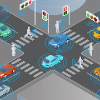With the pervasiveness of IoT devices, smart-phones and improvement of location-tracking technologies huge volume of heterogeneous geo-tagged (location specific) data is generated which facilitates several location-aware services. The analytics with this spatio-temporal (having location and time dimensions) datasets provide varied important services such as, smart transportation, emergency services (health-care, national defence or urban planning). While cloud paradigm is suitable for the capability of storage and computation, the major bottleneck is network connectivity loss. In time-critical application, where real-time response is required for emergency service-provisioning, such connectivity issues increases the latency and thus affects the overall quality of system (QoS). To overcome the issue, fog/ edge topology has emerged, where partial computation is carried out in the edge of the network to reduce the delay in communication. Such fog/ edge based system complements the cloud technology and extends the features of the system. This chapter discusses cloud-fog-edge based hierarchical collaborative framework, where several components are deployed to improve the QoS. On the other side. mobility is another critical factor to enhance the efficacy of such location-aware service provisioning. Therefore, this chapter discusses the concerns and challenges associated with mobility-driven cloud-fog-edge based framework to provide several location-aware services to the end-users efficiently.
翻译:随着IOT装置的普及、智能手机和地点跟踪技术的改进,产生了大量不同地理标记(地点特定)数据,从而便利了多种地点感知服务。这种时空(地点和时间大小)数据集的分析提供了各种重要服务,如智能运输、应急服务(保健、国防或城市规划)。虽然云层范式适合储存和计算能力,但主要的瓶颈是网络连通性丧失。在时间紧迫的应用中,需要实时响应来提供紧急服务,这种连通性问题增加了系统的总体质量(QOS)。为了克服问题,出现了雾/边缘表层学,部分计算在网络边缘进行,以减少通信延误。这种以雾/边缘为基础的系统补充云层技术,扩展了系统的特征。本章讨论基于云-泡沫的等级协作框架,其中部署了若干组成部分来改进QOS。在另一方面,这种连通性问题提高了系统的总体质量(QOS)。为了克服问题,雾/边缘表层数据集提供了基于该端定位的功能,从而增强了基于该端端定位的功能性框架。





